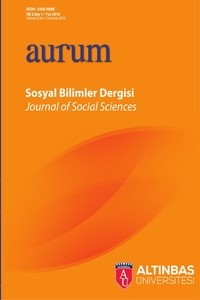ESTIMATING THE EFFECT OF INFLATION ON STOCK RETURNS USING REGIMEDEPENDENT IMPULSE RESPONSE ANALYSIS
ESTIMATING THE EFFECT OF INFLATION ON STOCK RETURNS USING REGIMEDEPENDENT IMPULSE RESPONSE ANALYSIS
AbstractThis study investigates the effect of inflation on stock market in South Africa with regime-dependent impulseresponse analysis. Nonlinear regime-dependent interaction is tested with the Markov switching vector autoregressionapproach between July, 1995 and July, 2017. The results show that there is a negative impactof inflation in the short-term, and that a long-term relationship does not exist. This indicates that commonstocks cannot be a hedge against inflation. The other findings relate to regime dependency and nonlinearcorrelation. I also found that movements of stock market are strongly regime-dependent. These results arerobust in controlling additional macroeconomic variables.
___
- Akaike, H. “A new look at the statistical model identification.” IEE Transactions on Automatic Control, 19(6) (1974): 716-723.
- Alagidede P. “Relationship between stock returns and inflation.” Applied Economics Letters. 16(14) (2009): 1403-1408.
- Alagidede P. and Panagiotidis, T. “Can common stocks provide a hedge against inflation? Evidence from African Countries.” Review of Financial Economics. 19(3) (2010): 91-100.
- Bodie, Z. “Common Stocks as a Hedge Against Inflation.” Journal of Finance. 27 (1976): 459-470.
- Boudoukh, J. and Richardson, M. “Stock returns and inflation, A long horizon perspective.” American Economic Review. 83 (1993): 1346-1355.
- Cifter, A. “Stock Returns, Inflation, and Real Activity in Developing Countries: A Markov-Switching Approach.” Panoeconomicus, 62(1) (2015): 55-76.
- Dickey, A.D. and Fuller A.W. “ Likelihood ratio statistics for an autoregressive time series with a unit root.” Econometrica, 49 (1981): 1057-72.
- Ehrmann, M., Ellison, M. and Valla, N. “Regime-dependent impulse response functions in a markov-switching vector autoregressive model.” Economic Letters, 78 (2003): 295–299.
- Elliott, G., Rothenberg, T.J. and Stock, J.H. “Efficient tests for an autoregressive unit root.” Econometrica, 64 (1996): 813–836.
- Engle, R.F., and Granger, C.W.J. “Cointegration and error correction: representation, estimation and testing.” Econometrica, 55 (1987): 251–276.
- Fama, E.F. “Stock Returns, Real Activity, Inflation and Money.” American Economic Review. 71 (1981): 545-565.
- Fama, E.F. and Schwert G.W. “Asset Returns and Inflation.” Journal of Financial Economics. 5 (1977): 115-146.
- Fisher, I. The Theory of Interest. New York: Macmillan, 1930.
- Geske, R. and Roll, R. “The Fiscal and Monetary Linkage between Stock Returns and Inflation.” Journal of Finance, 38 (1983): 1-38.
- Hamilton, J.D. “A New Approach to the Economic Analysis of Nonstationary Time Series and the Business Cycle.” Econometrica, 57(2) (1989): 357-384.
- Hamilton, J.D. Regime Switching Models. S.N. Durlauf and L.E. Blume (Ed.). The New Palgrave Dictionary of Economics. Hampshire, Palgrave Macmillan, 2008.
- Hondroyiannis, G. and Papapetrou, E. “Stock returns and inflation, A markov switching approach.” Review of Financial Economics. 15 (2006): 76-94.
- Jaffe, F. and Mandelker, G. “The “Fisher Effect” for Risky Assets, An Empirical Investigation.” Journal of Finance, 31 (1976): 447-458.
- Jarque, C.M. and Bera, A.K. “Efficient tests for normality, homoscedasticity and serial independence of regression residuals,” Economics Letters, 6 (3) (1980): 255–259.
- Kim, S. and In, F. “The Relationship between Stock Returns and Inflation, New Evidence from Wavelet Analysis.” Journal of Empirical Finance, 12 (2005): 435-444.
- Krolzig, H.M. Econometric modeling of Markov-switching vector autoregressions using MSVAR for Ox. Discussion Paper, Department of Economics, University of Oxford, 1998.
- Krolzig, H.M. Predicting Markov-Switching Vector Autoregressive Processes. Oxford University. Working Paper 2000W31, 2000.
- Krolzig, H.M. Markov Switching Vector Autoregression. Modelling, Statistical Inference and Application to Business Cycle Analysis. Berlin: Springer, 1997.
- Krolzig, H.M. Impulse-Response Analysis in Markov Switching Vector Autoregressive Models. Economics Department. University of Kent. Keynes College, 2006.
- Lintner, J. “Inflation and Security Returns.” Journal of Finance. 30 (1975): 259-280.
- Maghyereh. A. “The long-run relationship between stock returns and inflation in developing countries, Further evidence from a nonparametric cointegration test.” Applied Financial Economics Letters. 2 (2006): 265-273.
- Neftçi, S.. “Are Economic Time Series Asymmetric Over the Business Cycle?.” Journal of Political Economy, 92 (1984): 307-328.
- Nelson, C.R. “Inflation and Rates of Return on Common Stocks.” Journal of Finance, 31 (1976): 471-483.
- Sims, C.A. “Macroeconomics and Reality.” Econometrica, 48(1) (1980): 1-48.
- Ross, S. “The arbitrage theory of capital asset pricing.” Journal of Economic Theory. 13(3) (1976): 341–360.
- Zivot, E. and Wang, J. Modeling Financial Time Series with S-PLUS. New York: NY,Springer Science+Business Media, 2006.
- ISSN: 2458-9896
- Yayın Aralığı: Yılda 2 Sayı
- Başlangıç: 2016
- Yayıncı: Altınbaş Üniversitesi
